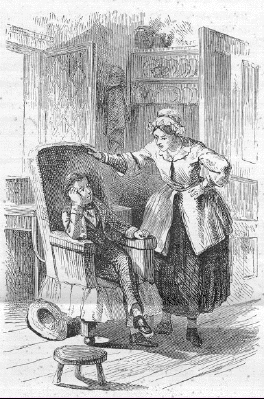- Image
1

Do you
portray a working class woman? What do you use as inspiration for
dressing yourself appropriately? If your answer is a CDVs or Godey's
you have much to learn about how you would have dressed for every day
wear.
Nineteenth century women were no different from us. When they had
work to do they dressed the part. Just as I don't clean house today
in a suit they didn't wear the finery we see in CDVs in going about
their daily routine.
On the other
hand I wouldn't go to have my photograph taken in the sweats or old
clothes I normally wear while doing housework and neither did our 19th
century counterparts.
If we can't
see the common working woman in a CDV where must we go to see what she
wore? One of the best sources is illustrations in books or
periodicals. The image above came from my personal collection of
American Sunday School Union books and papers. It is dated April l2,
l862.
What do we
see in this image that tells us what the average rural woman wore?
On the left
is a slovenly young woman who takes no pride in her appearance, her
work habits, or her surroundings. The article refers to her as a
"sluggard", stating real ladies are industrious whereas this
young lady is "slothful". Is she happy? No. "Of course she is not
happy. Idle people never are. She frets, and worries and makes
herself more disagreeable than a door with rusty creaking hinges."
"She makes nobody happy. She is a thorn in her mother's side, a
thistle under her little brother's feet, a teazle to her father's
heart."
The young lady on the right is referred to as Industrious. "Everybody
loves her", says her father. Alice has no time to fret, but she has
pride enough in her appearance to make herself presentable and is
shown as the epitome of a working woman. Compared to most CDVs or
Godey's fashion plates she is homely and humble, yet she is what the
reader was told a young woman in her daily routine looked like. She
is authentic to her surroundings and to her place and time.
Alice wears a basic one piece dress with what appears to be a gauged
skirt. She wears simple flat shoes which allow her to go about her
work with comfort. Her dress has a basic white collar. Her sleeves
are pushed up above the elbow allowing her to work without soiling the
sleeves. She wears a kerchief on her head to keep her hair free of
dirt and dust as she cleans, yet her hair is immaculately done with
obligatory center part. She wears a full apron which is approximately
three quarters the length of her skirt to prevent soiling of the
dress. She is obviously not wearing a hoop but does have skirt
support the sort which may be achieved with a corded petticoat. She
wears no jewelry but does appear to have a simple ribbon tie at the
collar.


In the second image we see another woman going about her daily
routine. She is dressed simply, but well. She wears a one piece
dress with gathered bodice. Her shoes are simple flats allowing for
comfort and easy mobility. Her dress has simple coat sleeves. She
wears an apron of striped fabric, and were she standing it appears to
have been about knee length or perhaps two thirds the length of the
skirt. Her hair is carefully styled though she is obviously at home
and going about the work of keeping house. Even though she is sitting
we can see that she has skirt support, probably a corded petticoat,
but not hoops. She does not appear to be wearing jewelry of any kind.
Her daughter is dressed very much as is her mother except that she has
the boat neckline of youth on her dress. The dress is striped fabric,
and she wears an apron very much like her mother's. Her hair is
parted in the middle, and carefully combed back behind the ear. She
wears stockings and simple flat shoes.

In this final image of a woman at home going about her daily routine
we note she is wearing a sacque and petticoat. The skirt is short
enough to allow for easy mobility either indoors or out. She can tend
to various chores outdoors without fear of a muddy wet skirt. Her
shoes are simple flats. The image appears that she is wearing the
sacque over a basic one-piece dress. The sacque shows a hint of
bodice underneath, and sleeves of the same color and look of the
skirt. There is also a white collar which appears to be attached to
the dress and turned down over the sacque at the neck. The sacque is
made in typical fashion - fitted closer about the bodice before
flaring out over the hips. If the woman were standing straight the
sacque would strike her at approximately mid-thigh length. Again,
there is no sign of jewelry or even trim to hint at anything but a
basic every day dress for working around the home. She is no doubt
wearing skirt support, again, most likely in the form of a corded
petticoat as the silhouette is not that of a cage. Just as we saw in
the previous two illustrations her hair is carefully dressed with
center part, and the hair is covered to keep it clean as she goes
about her work. None of these illustrations show slovenly loose hair
falling about the face or stuffed loosely into a net indicating that
even at home while going about their daily routine they took pride in
dressing the hair.
The second image is dated June 8, 1861, and the third is dated Nov. 9,
1861. All three images are from the Sunday School Advocate,
and are part of my collection of 19th Century Sunday School books and
papers.